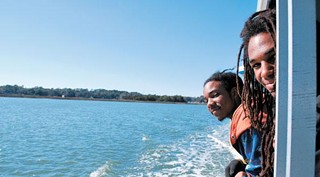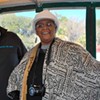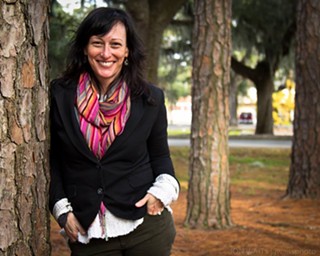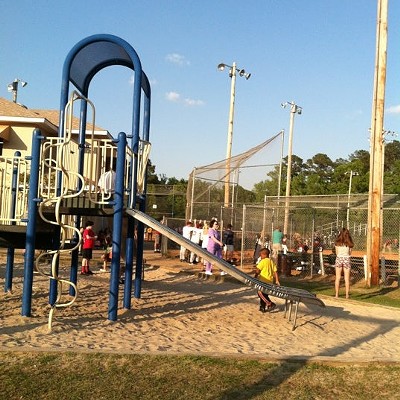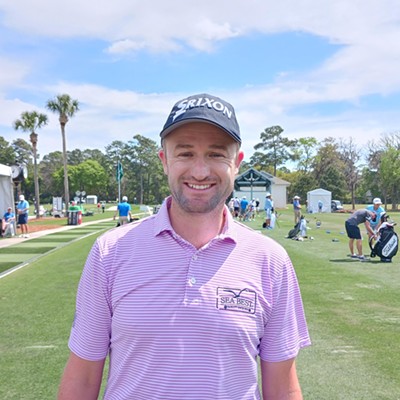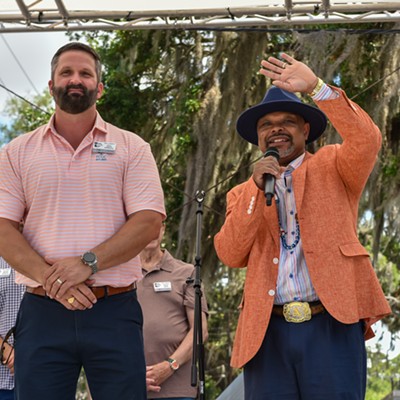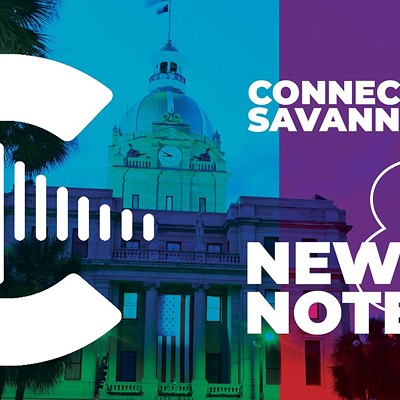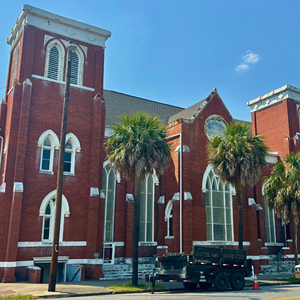Sunny skies, glassy waters, a gentle offshore breeze — the conditions couldn’t have been more perfect for a Saturday morning on the water.
Still, Captain Kofi Moyo seemed a little nervous. This was, after all, the maiden voyage of his new venture, By Water Tours, and he wanted everything to be just right.
In an area where dozens of guides offer lovely cruises and fine storytelling, Moyo’s concept has been uncharted thus far: Savannah’s waterways explored and explained within the context of African–American history.
As the forty or so guests descended the dock at Hogan’s Marina and began to fill the Island Explorer, Capt. Kofi fussed over the details: The apple cider — was it hot enough? Would the entertainment be on time? Most importantly, would the day’s agenda flow as smoothly as the river?
“This is a day for ‘firsts,’ and a day for ‘special,’” he announced once the seats were filled. “And I hope it’s an educational experience like you’ve never had.”
For this inaugural trip, Capt. Kofi partnered with his friend, Mike Neal, Bull River Tours captain and owner of the covered pontoon cruiser. As Capt. Mike navigated the vessel out Turner’s Creek, Capt. Kofi began to relax, giving a brief lesson on tides and pointing out egrets skimming the tops of the marsh grass.
“I have long had a love affair with this environment,” said the Chicago native, who first came to Savannah 16 years ago to bring his son to Savannah State. “And that it holds so much history gives it that much more meaning.”
To elaborate, he turned the microphone over to “docent for the day” Vaughnette Goode–Walker. Amiable and warm, Goode–Walker spends much of her time on land with her company Footprints of Savannah, a downtown walking tour that details Savannah’s slave trade and the fate of freed blacks after the Civil War.
Swaying to the strains of Paul Robeson’s “Old Man River,” she opened with an invocation that immediately established the connection between these waters and the Freedmen of post–Civil War Savannah.
“Let us honor the Freedmen’s struggle to own this land,” sweeping her arm along the banks of the Wilmington River, where huge rice plantations once thrived and hundreds of Africans were enslaved. “They hoped to till it, looking for the promises they never got.”
Those broken promises refer to Special Field Orders No. 15, better known as “40 Acres and A Mule,” issued in January 1865 by General Sherman after meeting with black leaders in the Green–Meldrim House on Madison Square. The declaration provided freed slaves with a standard–sized plot of tillable land from the massive acreage abandoned by Confederate plantation owners. The promise of reparation was dissolved within the year, however, when President Lincoln was assassinated and his successor, Andrew Jackson, nullified the order and returned the plots to their previous owners.
As the tour passed by the stately homes of Dutch Island and Isle of Hope’s Bluff Drive, Goode–Walker called out the names of the Freedmen who had briefly laid claim to these loamy grounds, many of them bearing the same names of those former plantation owners — Tattnall, Turner, Screven — linking the names of Savannah’s mainstream white history with the less aggrandized, parallel world of Savannah’s freed Africans and their descendants.
Many of the Freedman stayed on the land as sharecroppers and established thriving communities along the water, part of the historic Gullah/Geechee network of fishing villages that once stretched from Jacksonville to Cape Fear. The water was vital to their livelihood, providing food and a means of transportation for generations.
“We’re traveling the same path that people have used for hundreds of years,” observed Goode–Walker.
The boat passed by one of these historic communities, Pin Point, hidden in the shadow of the cement arc of the Diamond Causeway that joins the mainland to Skidaway Island.
“You would completely miss this by car,” pointed out Capt. Mike as he maneuvered the boat into the creek. “People live in Savannah their whole lives and never know this is here.”
The childhood home of Supreme Court Justice Clarence Thomas, Pin Point has a new red–roofed heritage center that isn’t yet open to the public. Capt. Kofi hopes his tour will bring more awareness to the center’s value.
“This is Savannah’s unique piece of a legacy that’s been so well–preserved in Florida and South Carolina,” he said. “We need to save it and share it.”
While the city’s African–American history has been fairly well–celebrated, even Savannah natives know little about the modest lives of these isolated communities.
“I’m from here, but I didn’t come out on the water much growing up. This opens up a whole new world to me,” said Omega Moore, associate professor of African–American literature at Savannah State. “It’s very interesting to see how these waterways connect us to Africa.”
Some of the day’s participants counted personal connections with the legacy. Keith Brooks brought his seven children on board to show them where his grandmother spent her childhood, gathering oysters and setting out crabpots near Thunderbolt at the turn of the century.
“She moved away when she was twelve, but she used to tell me stories,” said Brooks, who moved his family back to Savannah several years ago. “When I heard about this tour, I needed to see and experience this, to go the way they went.”
While the water’s past kept the audience rapt, the natural beauty of the present also captured plenty of attention as pelicans dove for whiting and dolphins swam in graceful loops. A bald eagle nest was spotted on the backside of Wormsloe Plantation, among old oaks that have stood since the time when the only humans around were neither black nor white.
After the stories, Capt. Kofi breathed easy as guests enjoyed a soul food lunch prepared by himself and locally–renowned chef Sula. Capt. Mike turned the boat for home, and the ride turned jovial as Nigel “Bokei” Jeffers played steel drums at the bow.
Now that the first tour is under his belt, Capt. Kofi discussed plans to cover more important African–American historic sites and to collaborate with other storytellers.
“Our work is to remind that Savannah’s African–American history is Savannah’s history, that Black history is America’s history,” he said as crabpots bobbed behind him. “There is a great link to all of it on the water.”
Info: (912) 713-5154 or ByWaterTours.com.

